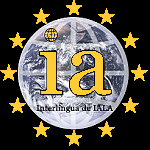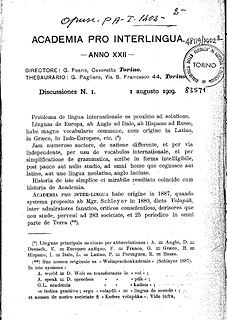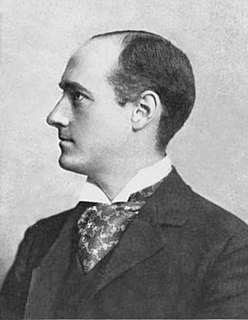
Interlingua is an Italic international auxiliary language (IAL) developed between 1937 and 1951 by the American International Auxiliary Language Association (IALA). It ranks among the most widely used IALs and is the most widely used naturalistic IAL – in other words, those IALs whose vocabulary, grammar and other characteristics are derived from natural languages, rather than being centrally planned. Interlingua literature maintains that (written) Interlingua is comprehensible to the hundreds of millions of people who speak Romance languages, though it is actively spoken by only a few hundred.

Interlingue, formerly Occidental, is an international auxiliary language published in 1922. Its creator, Edgar de Wahl, devised it to achieve a maximum of both grammatical regularity and natural character. The vocabulary is based on pre-existing words from various languages and a derivational system using recognized prefixes and suffixes.
An international auxiliary language is a language meant for communication between people from different nations who do not share a common first language. An auxiliary language is primarily a foreign language. It usually takes words from widely spoken languages.
Alexander Gottfried Friedrich Gode-von Aesch, or simply Alexander Gode, was a German-American linguist, translator and the driving force behind the creation of the auxiliary language Interlingua.
Idiom Neutral is an international auxiliary language, published in 1902 by the International Academy of the Universal Language under the leadership of Waldemar Rosenberger, a St. Petersburg engineer.

The Academia pro Interlingua was an organization dedicated to the promotion of international auxiliary languages, and is associated in particular with Prof. Giuseppe Peano's language Latino sine flexione.
Interlinguistics, as the science of planned languages, has existed for more than a century as a specific branch of linguistics for the study of various aspects of linguistic communication. Interlinguistics is a discipline formalized by Otto Jespersen in 1931 as the science of interlanguages, i.e. contact languages tailored for international communication. In more recent times, the object of study of interlinguistics was put into relation with language planning, the collection of strategies to deliberately influence the structure and function of a living language. In this framework, interlanguages become a subset of planned languages, i.e. extreme cases of language planning.
The Union Mundial pro Interlingua is a global organization that promotes Interlingua, an international auxiliary language (IAL) published in 1951 by the International Auxiliary Language Association (IALA). UMI was founded on July 28, 1955, when the first International Interlingua Congress took place in Tours, France. The UMI collaborates with the national Interlingua organizations and has a hand in publishing dictionaries, grammars and tutorials. It is a non-profit organization that now operates out of Bilthoven, Netherlands.
Herbert Newhard Shenton was a professor of Sociology at Columbia University and later at Syracuse University in New York. He was executive secretary of the International Auxiliary Language Association (IALA) from 1924 until his death in 1937. The interlinguistic work of IALA culminated in the publication of the Interlingua–English Dictionary and Interlingua Grammar in 1951. Through these historic works, IALA first presented Interlingua to the general public.
Ezra Clark Stillman (1907-1995) laid out the criteria for extracting and standardizing the vocabulary of Interlingua. In 1937, Stillman replaced William Edward Collinson as Director of Research at the International Auxiliary Language Association (IALA), which presented Interlingua to the public in 1951.
William Edward Collinson was an eminent British linguist and, from 1914 to 1954, Chair of German at the University of Liverpool. Like Edward Sapir and Otto Jespersen, he collaborated with Alice Vanderbilt Morris to develop the research program of the International Auxiliary Language Association (IALA). From 1936 to 1939, he was Research Director of IALA. Under Collinson's guidance, methods of compiling international word material were tested at Liverpool. In 1939 IALA moved from Liverpool to New York and E. Clark Stillman succeeded Collinson as Research Director. Alexander Gode, editor of the first English-Interlingua dictionary published in 1951, remained in contact with Collinson which had collected much of linguistic material in the University of Liverpool.

Alice Vanderbilt Shepard Morris was a member of the Vanderbilt family. She co-founded the International Auxiliary Language Association (IALA).
The Interlingua–English Dictionary (IED), developed by the International Auxiliary Language Association (IALA) under the direction of Alexander Gode and published by Storm Publishers in 1951, is the first Interlingua dictionary. The IED includes about 27,000 words drawn from about 10,000 roots. It also presents 125 affixes that facilitate free word formation. Its full title is Interlingua: A Dictionary of the International Language.
Novial was created by Otto Jespersen, who had also been a co-author of Ido. Both languages base their vocabularies primarily on the Germanic and Romance languages but differ grammatically in several important respects. Comparisons among Ido, Novial, and other notable international auxiliary languages have formed an important part of interlinguistic studies. For example, both Ido and Novial were among the languages investigated by the International Auxiliary Language Association (IALA), which developed Interlingua. This article is intended to provide an overview of the salient differences and similarities of Ido and Novial.
Interlingua: A Grammar of the International Language, sometimes called the Interlingua Grammar, is the first grammar of Interlingua. Released in 1951 by the International Auxiliary Language Association (IALA), it remains an authoritative reference work for Interlingua speakers and students of linguistics.
The Society for Science and the Public founded its Interlingua Division in 1953. The division made scientific research accessible to a wide audience by translating abstracts and several larger scientific works into Interlingua. The Interlingua Division also made publications of the International Auxiliary Language Association (IALA) available, facilitated contacts among professionals of the same discipline, and opened IALA's extensive library, which included technical and general dictionaries, to the public at no cost. Society for Science and the Public hired Alexander Gode as the division Director; Hugh E. Blair was his assistant.
Jeanne Martinet was a French semiotician and a proprietor of a semiotics school. Her husband was the eminent linguist André Martinet (1908–1999). In 1973, in Paris, Martinet published the book Clefs pour la sémiologie, which has been translated into numerous languages. In 1993, she co-authored, with her husband, the volume Mémoires d'un linguiste.

Dave Hennen Morris was an American lawyer, diplomat, and Thoroughbred racehorse owner who co-founded the International Auxiliary Language Association (IALA).
The International Academy of Volapük was a ruling body established at the second Volapük congress in Munich in August 1887 with the goal of preserving and improving Volapük.





